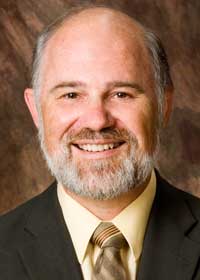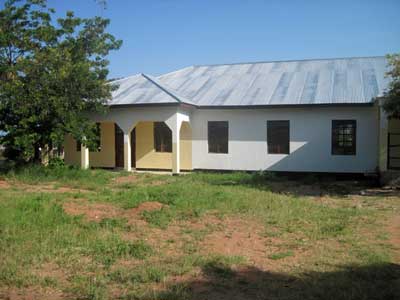What do a mountain, a nonprofit organization and the Division of Public Administration at NIU all have in common?
The director of the division in the NIU College of Liberal Arts and Sciences is planning to climb Africa’s highest peak, Mt. Kilimanjaro, in June.
Tanzania Development Support (TDS), a nonprofit organization co-founded by Thurmaier and his wife, Jeanine, is raising money to build a modern library and multipurpose resource center for Nyegina schools and nearby Bukwaya communities.
His fundraising goal is $19,341. Why isn’t the goal a round number? It matches the altitude of Mt. Kilimanjaro.
Fifteen people are going on the climb, including Thurmaier, Jeanine and their oldest daughter, Anna. The climb will take five days.
“There are no ropes or picks. When you get to about 18,000 feet on the last day of the ascent, you get up at about midnight. After eating, you take a step. Then you breathe. Then you take another step; and breathe. And you do that for about six hours. At dawn, you get to the summit where you can see the continent of Africa, which is supposed to be pretty cool,” he says.
And, he adds with a laugh, “there’s really no air up there.”
Thinking about his first climb, scaling a cirque in one of the Rockies in Banff, Canada, in 1977, he laughs again. “I was younger then. I’ve never attempted something like this.”

Dyonise (left), Thurmaier, Don Gosnay and Astrid Newenhouse hand bricks down the line at the Nyegina dorm. Courtesy TDS.
Thurmaier’s commitment to Tanzania began more than 30 years ago while he was earning his master’s degree at the Robert M. La Follette School of Public Affairs, University of Wisconsin-Madison.
During his time in Madison, Thurmaier met fellow student Leo Kazeri, a Catholic priest, who later would be assigned to the Musoma district in Tanzania. The two men formed a lasting friendship that survives 8,000 miles.
He first went to Tanzania in 2008, describing the experience as culture shock.
“Most people have not seen abject poverty. It’s very hard to explain. You may think you’ve seen it in big cities or in National Geographic, but it’s different when you’re actually living National Geographic,” he says. “Back home, it’s another kind of culture shock when you realize the disparity between the rich and the poor in this world.”
The library/resource center is the second project TDS is involved with in Nyegina.
The first project was the school’s dorm for girls. It took three years and $150,000 to build the dormitory, which houses 160 young women attending the school. It’s hard for Americans to understand why it took so long to build the dorm because, Thurmaier says, we live in what he calls “a hyper-efficient society. Everything here is go, go, go. The rest of the world is different. In Tanzania, nothing happens very fast.”
He points to “Kidogo, kidogo,” a phrase in the Kiswahili language that means, “little by little; slowly; step by step.”
“I think that’s how you have to think about investing in Tanzania,” he says, “little by little.”
Originally, Thurmaier was told it would cost $40,000 to build a dormitory. But that would only provide a building that consisted of a large room with four walls and a roof where 50 girls would live in one open space.
When he revised the building plans to add a dozen flush toilets and a dozen showers with semi-private living areas where eight girls would live together, the cost tripled.
“We have learned patience. We have this. Now we do this. The next step is that. And so on – one step at a time. You know where you’re going on the journey, but you have to realize it’s going to take a while to get there,” he says. “If you can accept that, then you can put one foot in front of the other and move forward, which is apparently what it takes to climb Kilimanjaro.”
Building the dormitory was just one step in educating girls in this part of the world.
In Tanzania, the decision to send a girl to school involves more than a place to live or the cost of the education. Sometimes life gets in the way, or family demands don’t allow girls to stay in school – even in primary grades. If the girls aren’t at home, who will fetch fuel for the fire for cooking? Who will help take care of younger siblings?
Assuming the young girl’s situation allows her to stay in school, the environment she goes back to upon graduation might not support success. There are a lot of issues to consider and a larger community to address. For example, boys must be taught to respect educated girls. The world in which these girls return to and have to live in shapes their future.
Meanwhile, many different types of support must be in place to sustain success of the mission.
“We can succeed here because our two core partners, the Catholic church and UMABU (Umoja wa Maendeleo ya Bukwaya), a grassroots secular organization, are of the region,” Thurmaier says. “Both have been around for a long time. They are not going away. We have sustainability.”
Support must come from others, too.
Architecture for Humanity Chicago (AFH Chicago), a collaborative group of volunteer design professionals and students, is preparing designs for the library/resource center project. Through architecture and design, this charitable organization addresses a broad range of issues such as food access, education, community development and open space.
“Because this is a grassroots effort, (Nyegina is) driving the project. They are telling us what they want. We’re not coming in and telling them what they need,” says Laura Bowe, co-director of AFH Chicago. “UMABU will hire a local architect of record who will finalize the design and oversee construction of the building.”
There are many opportunities for people to be involved, Thurmaier says.
“Development works best when you attack different problems in the same place at the same time. It doesn’t happen very often because you need a ‘policy entrepreneur.’ This is a person who has the necessary connections and brings resources together for focused applications,” he says. “I have a vision to bring as many pieces of NIU as possible to Musoma. I want to connect as many resources at the university as I can to this place.”
NIU’s Study Abroad program is helping TDS make connections in Tanzania with trips that teach students about the role of nongovernmental organizations (NGOs) that include language study, engagement in building projects, and a safari in the Serengeti National Park.
Andrew Otieno, adviser to NIU’s chapter of the national Engineers Without Borders organization (EWB-NIU), has been connected to TDS since 2009 after Thurmaier’s return from the first study abroad trip to Tanzania. Otieno and Thurmaier jointly requested a grant from the NIU Foundation to fund the first solar lighting project at the school. EWB-NIU completed that project in the summer of 2010, and six classrooms are now fitted with stand-alone solar lighting systems.
“EWB-NIU is continuing to work with Dr. Thurmaier at the Nyegina school. During last winter break, they installed an improved cooking stove and a solar water heating system for the kitchen. This effort was funded by the College of Engineering and Engineering Technology, largely through a grant from the OMRON Foundation,” Otieno says. “EWB-NIU’s goal is to make the school run on sustainable energy. Our next project is to determine the feasibility of having the school’s lighting system tied to a central solar-powered system.”
Currently, TDS is working with Becky Hunt, assistant professor in the Department of Educational Technology, Research, and Assessment in the NIU College of Education. Hunt will assist with organizing the Nyegina resource center.
In the future, Thurmaier says, “I would love to get NIU’s Environmental Studies people working on some issues, too.”
After the climb, Thurmaier will stay on for another week to attend a conference in Nairobi with a former student, Obuya Bagaka (a 2009 political science alum). Bagaka works for the Kenya Institute of Administration, which recently signed an agreement with the University of Nairobi to start a master’s level program in public administration.
Several other schools in the area have since also started MPA programs. At the conference, school officials will discuss curriculum and the core issues that American institutions like NIU have struggled with over the past 50 years. Thurmaier’s participation at the conference ties into a strategic goal of NIU’s Division of Public Administration to be a globally active program.
Work in Tanzania brings challenges, Thurmaier acknowledges, but those efforts plant worthwhile seeds.
“While it is pretty ambitious to want to save the world, it is not too ambitious to make life better in one spot; you can make a difference in one spot,” he says. “By focusing your attention and investing personal resources in one place, you can improve the lives of a whole bunch of people who will, in turn, improve their communities. The multiplier effect is huge.”
Read more about it:
- AFH published a booklet outlining the Nyegina Library and Multipurpose Resource Center project.
- U.S. News and World Report ranks the Master of Public Administration program fifth nationally in the specialty field of city management and urban policy and 12th in the specialty of public finance and budgeting.
Related:
- A land of great contrasts, enduring lessons
- NIU’s renowned public administration program stepping up its profile on world stage
by Rachelle Korth




